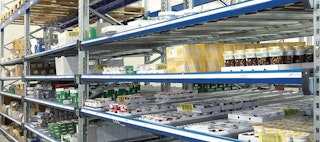Facts & Challenges
The food and beverage industry is one of our top-selling sectors. Demands on proper storage are particularly high in this sector. Foods are more prone to perishing than many other products which is why an efficient workflow is key to ensure food safety. Complying with freshness and hygiene standards, considering various refrigeration options, establishing different temperature zones, ensuring continuous cold chains and observing best-before dates constitute particular challenges for the storage and handling equipment as well as for order picking. It is also important that the storage system offers maximum versatility to allow customers to instantly respond to variations in demand resulting from seasonal peaks, promotional offers and other industry-specific conditions.
Regardless of whether products are to be sold in stores or online, the smooth flow of goods is an essential condition for success for any food and beverage business - from storage over order picking to distribution to the customer. Only fresh foods and top quality will keep customers over the long term and help companies to create a sustainable competitive advantage.

E-foods: The right storage solution will help providers optimise logistics and boost sales
Consumers in Germany spend approximately 215 billion Euros on food, beverages and tobacco products every year. Compared to non-food purchases (especially fashion, electronics and media), consumers are still relatively cautious when buying food over the Internet. But the trend is pointing upward.
The most popular grocery products in the online food segment are long-life luxury products such as wine, coffee, tea, sweets or specialties that are hard to find elsewhere. Products such as beverages and frozen foods also have a big growth potential, all the more so since customers had these products delivered to their homes long before the Internet existed. For all other foods, such as fresh produce or dairy products, the share of sales via e-commerce is still small. However, the number of customers who are basically interested in buying food or other daily necessities online has reached a share of approx. 19% in 2016 and has been rising for years.(Source: Statista) According to the study, (potential) buyers want deliveries to come free of charge, fast and within a fixed delivery slot.
Customers claim that the biggest benefits are:
- Independence from opening hours (56%)
- Home delivery (55%)
- Saving time (53%)
Customers also appreciate the convenience of online shopping, greater choice and lower prices.
Multi-channel logistics changes business models
Click & Collect is a widespread hybrid e-commerce model in which customers order their groceries online on the supplier's website and pick them up in-store or at a centralized collection point. The "online shopping with delivery service" model implements the convenience idea even more rigorously. However, logistics requirements are higher since a consistent strategy for storage, dispatch and handling returns is needed.
In the food & beverage sector, business success is no longer a question of choosing between online shopping or store shopping. The biggest lever for gaining the competitive edge on the market is to provide both ways in a perfect combination. Many shoppers appreciate the convenience of online shopping, but at times, they also want to touch, smell and taste their food at the counter and then take it home right away. Another difficulty is that long-established online retailers and classic chain stores are each expanding into the other's territory.
How can you attract more customers to your online grocery store?
Retailers who use the online market as a sales platform and want to win over customers in the long term must convince with free deliveries, short delivery times and fresh products.
Trends in food retailing
- Sales surfaces in retail markets are diminishing.
- Instead of new retail stores, more distribution centres and decentralised warehouses are being built.
- The requirements for picking and distribution (capacity & efficiency) continue to increase.
- Although customers order groceries online, they may want to choose "their" location and pick the best time to collect their shopping. (Click & Collect)
- Chia seeds or Goji berries are only some examples of how product diversity has increased. No matter how "exotic" products are, the customer will always expect his products to be fresh and available upon demand. Products that have already travelled thousands of kilometres around the globe must not be allowed to lose any of their value on the final step to the customer.
- Experts predict that the market share of online food orders in Germany will increase from currently 0.3% to 10% by 2020, which will pose new challenges for picking and distribution. In traditional store business, ownership of the goods is transferred to the customer at the cash desk. In contrast to this, the new delivery service of online platforms must ensure that vegetables, meat and ice cream still look appetizing when they arrive at the customers' doorstep.
- On top of this, the market for all kinds of frozen food keeps growing. Portionability and preservation properties are particularly important for single households. One key to understanding shopping behaviour is the increased importance consumers are attaching to convenience considerations. The trend also shows an above average need for energy-intensive refrigeration and deep-freeze logistics. Optimum warehouse planning and layout determine at an early stage how energy-efficient products can be stored.
- The individualism of our society is also reflected by an increased demand for special foods. Foods should do more than "just" fill you up. They often embody health, wellness and lifestyle. New trends are reshaping customer expectations and also the goods that customers want to see on the shelves. Modern food logistics must be able to cope with this variety, no matter whether customers prefer conventional, organic, lactose-free, low-sugar or gluten-free products.
Requirements
A much-discussed problem of the food and beverage industry is the enormous amount of food discarded along the entire food supply chain, from primary production to end household consumer level. In this context, the best before date (BBD) plays an important role. Criteria such as appearance, smell and external condition of non-packaged food, e.g. fruit and vegetables, determine the period of time during which the goods can be sold to customers. The duration of this time frame depends primarily on the way in which the goods are handled along the supply chain, in particular on maintaining the recommended storage temperature throughout the entire cold chain. Increased margin pressure in the frozen food industry due to rising energy costs illustrate the relevance of logistics. In terms of facts, this means that storage and order picking equipment must be cold-proof and enable maximum volume utilisation. In addition, the enormous product variety and the demand that goods must be permanently available make storage and picking requirements ever more complex.
All customers who purchase groceries online expect goods to be fresh and to be delivered fast and at no extra charge to their doorstep. Working with a storage solution that is perfect for your business will help providers to meet these expectations and win new customers for online shopping. Compact storage at the correct temperature is as essential for providers as is efficient order picking of food delivery orders. RFor customers, it is important that groceries are delivered fresh, fast and at no charge or at least against a small charge only. Finally, it is important to ensure an unbroken cold chain from the transportation hub to the final destination at the customer's doorstep (Last Mile Logistics). This can be achieved with packaging options that keep products at the required temperature for a certain period of time, i.e. delivery is independent of physical goods acceptance by the customer. All these requirements show that providers need efficient logistics to ensure top quality delivery and customer satisfaction.



![[Translate to en-za:] The food sector is a highly competitive market with a great sensitivity to changes and, often enough, with very low profit margins. High-performance logistics will make companies more profitable, generate more customers and ultimately increase profit margins.](https://assets.bitocloud.net/Bilder/Loesungen/Branchen/food-and-beverage-haltbarkeit-paprika.jpg?fit=scale&h=960&ixlib=php-2.1.1&q=80&w=1280&s=ca75730018e886a00cad8250b76b3a69)